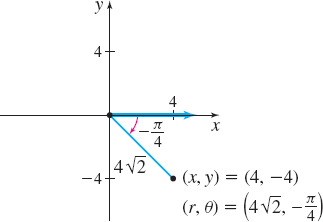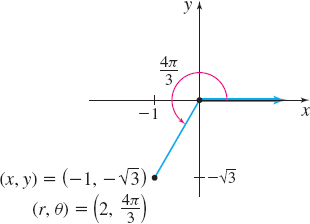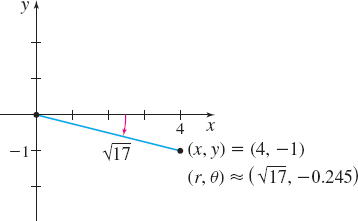EXAMPLE 4Converting from Rectangular Coordinates to Polar Coordinates
Find polar coordinates of each point whose rectangular coordinates are:
(a) (4,−4)
(b) (−1,−√3)
(c) (4,−1)
Solution (a) The point (4,−4), plotted in Figure 35, is in quadrant IV. The distance from the pole to the point (4,−4) is r=√x2+y2=√42+(−4)2=√32=4√2
Since the point (4,−4) is in quadrant IV, −π2<θ<0. So, θ=tan−1(yx)=tan−1(−44)=tan−1(−1)=−π4
666
A pair of polar coordinates for this point is (4√2,−π4). Other possible representations include (−4√2,3π4) and (4√2,7π4).
(b) The point (−1,−√3), plotted in Figure 36, is in quadrant III. The distance from the pole to the point (−1,−√3) is r=√(−1)2+(−√3)2=√1+3=2
Since the point (−1,−√3) lies in quadrant III and the inverse tangent function gives an angle in quadrant I, we add π to tan−1(yx) to obtain an angle in quadrant III. θ=tan−1(−√3−1)+π=tan−1(√3)+π=π3+π=4π3
A pair of polar coordinates for the point is (2,4π3). Other possible representations include (−2,π3) and (2,−2π3).
(c) The point (4,−1), plotted in Figure 37, lies in quadrant IV. The distance from the pole to the point (4,−1) is r=√x2+y2=√42+(−1)2=√17
Since the point (4,−1) is in quadrant IV, −π2<θ<0. So, θ=tan−1(yx)=tan−1(−14)≈−0.245 radians
A pair of polar coordinates for this point is (√17,−0.245). Other possible representations for the point include (√17,tan−1(−14)+2π)≈(√17,6.038) and (−√17,tan−1(−14)+π)≈(−√17,2.897).


